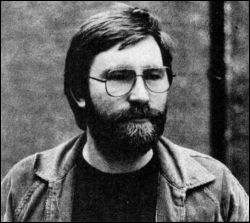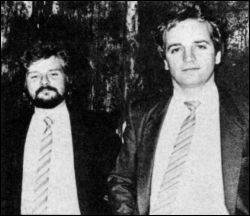|
First impressions of its technical specifications make the Sinclair Loki seem excellent value for money.
Being able to run both 48K and 128K Spectrum software would make it an ideal upgrade for existing Spectrum users and a good choice for first time buyers.

John Ritman |
The projected specification shows impressive expandability. However most programmers will write only for the 'standard' machine - games which require the user to own extra hardware (such as extra memory) have a much smaller sales potential - so its success as a new machine in its own right depends on the 'standard' specification.
Does the SuperSpectrum pass the test? First, the machine is attractive to programmers because the microprocessor (Z80H) is fully compatible with the well known Z80A as used in the Spectrum, Amstrad and MSX computers.
The most impressive aspect of the machine is the high resolution screen display. Imagine the screen from a current game like our own Batman with twice the detail and 16 colours! The blitter is an excellent and essential addition to the screen display to allow fast graphic handling and screen scrolling.
So far, so good, but here we come to a major pitfall in the otherwise excellent standard specification - 128K of memory is pitifully inadequate for this machine. Consider Batman on the 48K Spectrum, it uses 22K of memory to store its graphics. In the example above with twice the resolution and 16 colours, it would require 176K just for graphics; when 53K of the original 128K is used for screen alone we would say that a minimum memory requirement is 256K to make the machine viable with 512K being preferable.
As our experience with Fairlight synthesisers is limited to Kate Bush albums we feel a bit unqualified to comment on this part of the specification, however it should be possible to produce speech and superb sound.
Apart from the very serious memory limitations, £200 for the specifications described so far would be superb value for money. When you look at the full specification of the machine and discover numerous interfaces, ports and free software on top of the graphics and sound it begins to seem too good to be true.
It is difficult to imagine such a machine being available for under £500. A machine with comparable sound and graphics, the Commodore Amiga, costs £1900.
A careful examination of the Loki SuperSpectrum will undoubtedly hearten programmers, particularly those whose imagination outpaces the graphics available on the present generation of home computers.

But the facilities offered will not just mean improvements to games and utilities that are already available; the suggested Loki machine could open up whole new areas to home computing.
At present the only home machine to be used for video production is the BBC micro because it can have a 'GenLock' facility added (at a minimum cost of £70) - the SuperSpectrum will have this as standard. GenLock allows you to control the computer's screen display so that it runs at the same line and frame frequencies as other video sources: only when these are 'in sync' can you cut or mix the computer's output with a video camera or recorder. With a simple vision mixer and fairly straightforward software, the SuperSpectrum could be become a machine for adding titles, logos and roller captions to home videos. What's more, it can outshine the BBC micro with its speed of animation and greater colour range. Indeed, the quality of lettering will be such that the SuperSpectrum would be capable of finding its way into industrial and even broadcast-quality studios.
If you have no plans to shoot and edit your own videos, you may still find a use for the sophisticated video features: the frame grabber should be able to snatch pictures from the TV for you to alter and use in your own graphic displays, while the blitter technology will bring video effects to computer games - the zooms, tumbles, flips and wipes at the moment so fashionable on TV and rock videos.
Anyone who has played some of the interactive videodisc games available in the arcades may be wondering if the features of the SuperSpectrum will allow you to play this type of game in your own home. The answer is a guarded yes. Yes because all the required outputs and inputs are available, but guarded because the cost of the videodisc player (currently around £300) and other hardware may well be a stumbling block.
The SuperSpectrum - if it comes off - will vastly expand the horizons of low-cost computing.
The specification of the Loki is a gamesplayer's dream. The power of the micro to animate graphics depends on two main factors.
First, screen resolution. The higher the resolution the more detailed the graphics. However, high resolution means more data to move to the screen. In the most useful display mode for games the pixel resolution of the Loki is similar to that of the Spectrum. But the colour resolution is at pixel level making the memory map a huge 53K bytes.

Second, the data-to-screen speed. This is where the Loki will leave all other affordable micros far behind. Using hardware it would be possible to move data at many times the fastest software routine. Using the Spectrum the fastest way to move a byte by software takes 56 microseconds. With hardware - like the Loki - the limiting factor is the speed of the chips, say a maximum of 1000 times as fast.
My guess is the Loki would be able to move screen data at 24 times the Spectrum speed, the same rate as its video output. This gives it three times the animation power of the Spectrum and in proper pixel colours. If clever buffering techniques are employed by the programmer to limit the amount of data output to the screen animation rates of up to 50 cycles a second could be achieved. This gives the smoothness of movement that is now achieved by state-of-the art games machines.
Uridium on the C64 is animated at this rate and is a good example of the quality to expect. Of course where Uridium strains the last ounce of power out of the poor CPU the Loki's CPU would be hardly used for the screen display leaving it to run the game algorithms. Therefore more sophisticated game designs could be made to run with the same smooth cartoon quality.
In the mode I am considering the Loki would provide a choice of 62 colours in each pixel. This means there would be three shades of each primary colour, not enough for fine graduation shading but more than adequate for most purposes.
The drawback to so many colours is the extra space needed to store all the graphics. A typical Spectrum game holds 15K of graphics data. This could take 120K of the Loki's user Ram and the standard machine will only have 64K. So packing methods will have to be used limiting each object to say two or four colours.
For the first time real sound effects could be used in a game. Imagine an arcade adventure where the sound is used like a film soundtrack to add to the atmosphere and suspense, echoing footsteps are heard, a door creaks open, a blood chilling scream fills the air ...
The limiting factor will again be the space to store digital sound patterns. What will be more likely is the use of algorithms to manufacture the electronic tones we associate with arcade games.
The musical possibilities are such that the machine would be used by serious musicians. Connect a keyboard with suitable software and you have synthesiser capable of sampling, sequencing or the modelling of totally new sounds.
Just when I thought I had to save up a thousand pounds to own a dream machine here is a possibility, perhaps remote, that I could own one for a mere £700.
The Loki will do almost anything a home computer ever has to do, and a lot more besides. The main things that impress me about it are the 7MHz clock rate, which makes it run faster than anything else (most 68000 machines included), the amazing graphics and the Ram potential.
As mainly a systems programmer I would like to write 'standard' programs but with very neat graphics, something which has rubbed off after programing the Amiga. For something straightforward like a screen editor there are loads of different things that can be done to make it easy (and fun) to use including icons, multi-windows and menus. Even without a mouse (I don't think one comes with Loki) with its good graphics capability any program could be made neat to look at and easy to use.
If Loki can run CP/M, unlike the Spectrum 128 (because you can't page in Ram at location 0) then it should knock the Amstrads for six, thanks to its clock speed and hardware-assisted graphics. It would need a disc Interface though. Loki could do well as a small business machine (watch out the PCW8512) as it can display 80 characters (at last!), have a lot of memory, and has a proper keyboard (at last again!).
One thing that does worry me is how all the hardware is going to be accessed via software, and Sinclair in the past has been terrible when it comes to defining entry points for programmers - the old 16K Rom could only be used when Ian Logan's book came out, the Interface 1 Rom has to be called directly for most things, and the Spectrum 128 Rom has even fewer entry points. With all of these Roms any changes made have caused real compatibility problems. There is supposed to be a massive amount of in-built software but it would cost a fortune to commission the relevant companies and the amount of Rom space would be massive.
I would very much like the Loki to see the light of day, but Amstrad could kill their other machines off with it.
It is simply the best machine yet mooted for games, could do well in small businesses if it runs CP/M, and could do very well as a poor man's Amiga for video effects and sound generation.
The concept of the 'computer movie' is trotted out with depressing regularity in the ad blurbs for many a new game.
Nevertheless, it is an ideal that Gargoyle has always pursued in our adventure series. A machine like the Loki could bring the realisation of such an ideal several steps closer.

The problems currently encountered in trying to produce life-like images on a Spectrum screen are ones of scale.
The resolution of a Spectrum screen is such that small images lack the definition to look life-like - when a pixel is half the total width of a character's arm, the result is distinctly 'computeresque'. The solution to this is to use larger images, somewhere around 56 to 80 pixels tall.
Large images occupy masses of internal store - for the main character in a game, we normally require 50 or 60 individual 'frames' to ensure the animation is as smooth as possible.
With a machine like the Loki, however, these irritating 'little' problems begin to evaporate. For instance:
While the most likely resolution for game production is 256x212 pixels which is comparable to the Spectrum, the use of individually coloured pixels would allow colour-shading to give a solid and realistic picture.
A 7 MHz chip and all its associated interrupt-handling capabilities means that the screen display will not slow down the working of the CPU. Couple this with the 'blitter' technology embodied in the Rasterop hardware and imagine tall alien figures moving casually through the sort of 3D landscape only previously seen in the Amiga version of The Pawn.
Of course, to store all this additional information needs all of the 128K Ram and the mighty back-up of a 1 Mbyte Softcard.
A further point of interest is the speculation that the Loki will be provided with the means to capture and display input video pictures. We have been experimenting for some time with digitised input on everything from Spectrums to IBMs and we have no doubt that a lot can be achieved in the production of life-like computer graphics via this technique.
So, while the fantastic sound chip, the enhanced Basic and the light pen are tremendous bonuses, the Loki could provide the chance to direct that elusive 'computer movie'.
That's tempting, very tempting ...